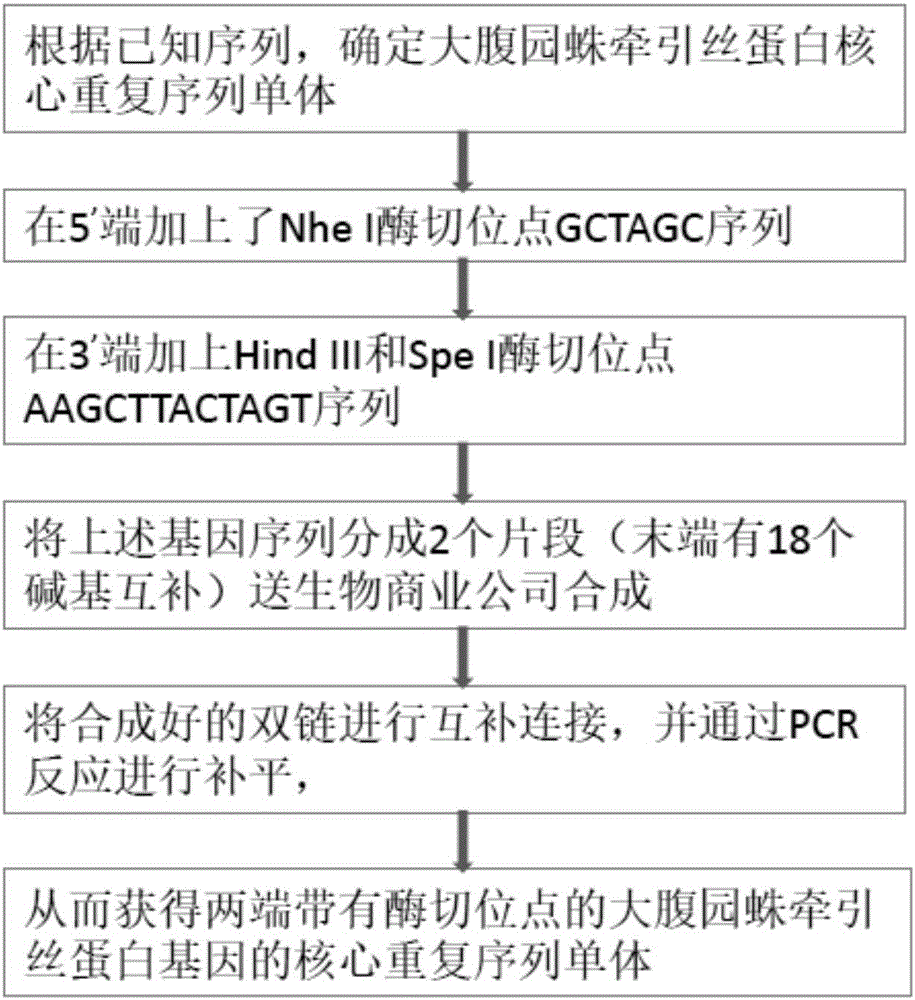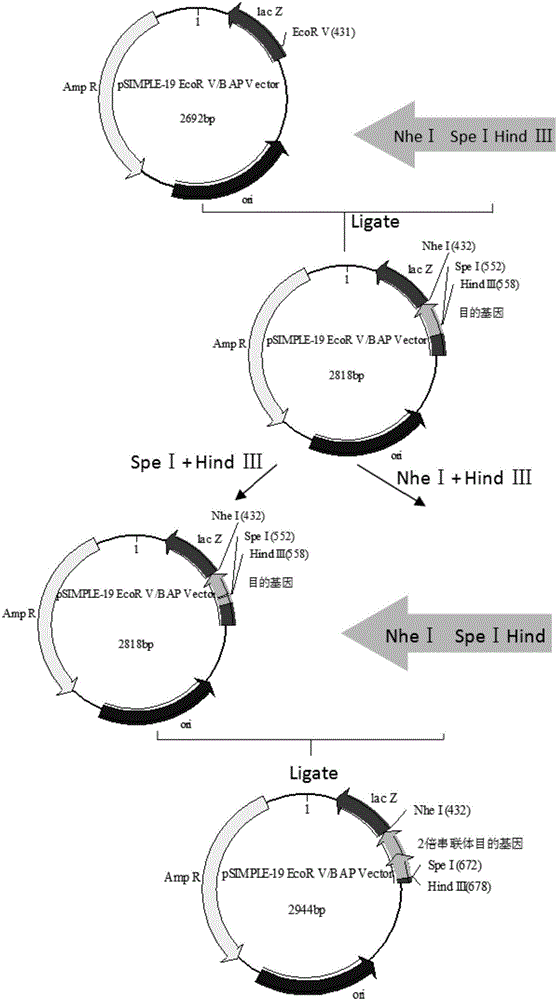Artificially constructed araneus ventricosus dragline silk protein gene and construction method thereof
A technology of dragging silk protein and Edenia spp. applied in the field of genetic engineering, which can solve the problems of low spider silk production, inability to raise spider silk at high density, and difficulty in processing full-length gene sequences, so as to save costs and improve work efficiency , The process is simple and efficient
- Summary
- Abstract
- Description
- Claims
- Application Information
AI Technical Summary
Problems solved by technology
Method used
Image
Examples
Embodiment 1
[0059] Example 1 Preparation of Monomer Sequence of Tractor Silk Protein Gene
[0060] The flow chart is attached figure 1 shown.
[0061] 1. According to the published partial cDNA sequence of the pulley silk protein of E. grandina (JN857964.2), determine the core repeat sequence 108bp (as shown in SEQ ID NO.1) as the basic gene composition of the monomer.
[0062] Then in the above core repeat sequence 5 ’ The Nhe I restriction site GCTAGC is added to the end, and the Spe I and HindIII restriction site ACTAGTAAGCTT is added to the end. The total length of the sequence thus formed is 126bp (as shown in SEQ ID NO.2), which is the pull silk Monomer sequences of protein genes.
[0063] Two oligonucleotide single strands (72bp, sequence shown in SEQ ID NO.3) are artificially synthesized from both ends of the gene monomer, and 18 bases are complementary at the ends of the two oligonucleotide single strands.
[0064] 2. Take 100ng of the two synthesized oligonucleotide chains (...
Embodiment 2
[0065] Example 2 Construction of pSIMPLE-19 EcoR V / BAP monomer recombinant plasmid
[0066] 1. Take 5uL of the double-stranded sequence of the pulley silk protein gene monomer of the above-mentioned fill-in product, and carry out agarose gel electrophoresis, and use Takara’s TaKaRa MiniBEST Agarose Gel DNA Extraction Kit Ver.4.0 gel recovery kit to detect the target article Take 126bp for rubber tapping recovery.
[0067] 2. Phosphorylate the above-mentioned reclaimed leveling product:
[0068] The reaction system is:
[0069] wxya 2 O 10.25 μl,
[0070] 10×T4 DNA Polynucleotide Kinase Buffer 2.5 μl,
[0071] 12 μl of the above recovered fill-in product,
[0072] ATP 25 nmol (0.25 μl),
[0073] T4 Polynucleotide Kinase 10 units.
[0074] The reaction conditions are: react at 37° C. for 30 minutes.
[0075] 3. Then connect the phosphorylated fill-in product to the pSIMPLE-19 EcoR V / BAP expression vector:
[0076] The reaction system is:
[0077] pSIMPLE-19 EcoR V / BAP ...
Embodiment 3
[0084] Example 3 Constructing multiple concatemers of the core repeat sequence of the pulley silk protein gene
[0085] 1. Cultivate the bacterial solution transformed with the pSIMPLE-19 EcoR V / BAP haploid recombinant plasmid, and extract the plasmid using the TIANprep Mini Plasmid Kit.
[0086] The plasmid was double-digested with restriction endonuclease Nhe I / Hind III, and the reaction composition and steps were as follows:
[0087] pSIMPLE-19 1×plasmid 2μg
[0088] 10 × Quickcut buffer 5μL
[0089] NheI 1 μL
[0090] HindⅢ 1μL
[0091] dd H 2 O to make up to 50 μL.
[0092] The above reaction system was mixed gently, centrifuged briefly, and incubated at 37°C for 2h.
[0093] 2. Separate by 1% agarose gel electrophoresis and analyze the size of the fragments (see Figure 5 ), using the DNA gel extraction kit (TaKaRa MiniBEST Agarose Gel DNA Extraction Kit Ver.4.0) to recover the target gene fragment; then the single recombinant plasmid was double-digested with rest...
PUM
 Login to View More
Login to View More Abstract
Description
Claims
Application Information
 Login to View More
Login to View More - R&D
- Intellectual Property
- Life Sciences
- Materials
- Tech Scout
- Unparalleled Data Quality
- Higher Quality Content
- 60% Fewer Hallucinations
Browse by: Latest US Patents, China's latest patents, Technical Efficacy Thesaurus, Application Domain, Technology Topic, Popular Technical Reports.
© 2025 PatSnap. All rights reserved.Legal|Privacy policy|Modern Slavery Act Transparency Statement|Sitemap|About US| Contact US: help@patsnap.com



